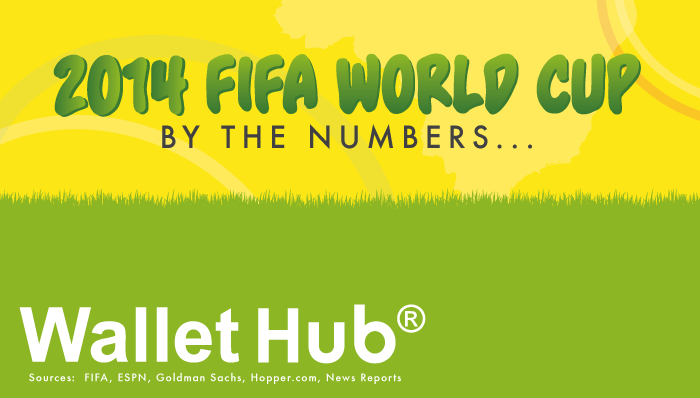Much has been written about Brazilians’ discontent with the amount of money spent in hosting the World Cup this year. It’s been somewhat jarring given Brazil’s reputation as the arguable epicenter of soccer, though it’s consistent with the shade cities are casting toward hosting the Olympics in coming years.
The infographic below, provided by financial services social network WalletHub, looks at the business side of the global spectacle (which, to be clear, I’ll be parked gleefully in front of all month). Among the data points: this year’s tournament cost about $11 billion to host—up from $4 billion for 2010’s tournament in South Africa. Meanwhile, soccer’s governing body, FIFA, has made about $4.65 billion off the tournament, about 65 percent of which comes from TV rights. And whichever nation wins the World Cup has, historically, seen a brief boost to their economy.
The infographic also looks at some of the expected tourism numbers. The tournament is expected to bring 3.7 million people to World Cup sites, 600,000 of whom will come from overseas. The average foreign tourist is expected to spend about $2,500.
On the flip side of that $2,500 number, however, and not highlighted directly on the infographic: South Africa spent about $13,000 per foreign visitor, according to CNN Money. While Brazil is expected to bring in more than double the foreign tourists compared to South Africa a few years back, it’s also spending more than twice as much, so the numbers for Brazil are actually more expensive at more than $18,000 per visitor. That $2,500 in tourism spending per foreign visitor suddenly looks a whole lot less exciting.
One more business lowlight from the World Cup (for now). Several sponsors have expressed their own distaste for the possible corruption surrounding a future World Cup—the 2022 tournament, currently scheduled for Qatar. That tournament had long been rumored to have been awarded on bribery, and a recent report in the Sunday Times laid out the evidence showing the allegations might be true. (Qatar never looked like a great spot for the World Cup because it gets extremely hot in the summer, and many have suggested players would be unable to sustain the heat. It looked all the worse when reports surfaced that hundreds of migrant workers have died in preparing the country for the tournament.)
FIFA sponsor Adidas said this weekend the allegations of corruption have the company concerned—though it’s a little hard to believe any company partnered with the often-shady organization would be all that shocked by chicanery.
Check out WalletHub’s infographic below.









Leave a Reply
You must be logged in to post a comment.